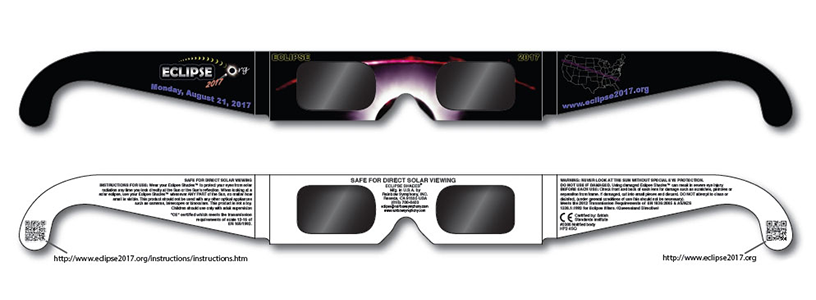Why are they called “eclipse glasses”? Do you need them if you’re in the path? What about if you’re not in the path?
 (You WILL need them – get them now!)
(You WILL need them – get them now!)
To answer these questions, we need to tell you some important things about total solar eclipses.
FIRST, please go to the page that hosts the 2017 instructions for watching an eclipse, and read them – you have a few languages to choose from. ☺ (Here is a direct link that takes you right to the document.) Then, go to pages 8 and 10 of the PDF. This is a quick summary of what you’ll read in this document:
IF YOU ARE IN THE PATH:

If you are in the path of totality, you will (not surprisingly!) see “totality”, the brief period of time when the Moon is completely covering up the Sun. But BEFORE you see totality, you will see partial phases of the eclipse as the Moon slowly covers more and more of the Sun. And then AFTER totality, you will again see partial phases of the eclipse as the Moon moves off in its orbit around the Earth.
During totality ONLY, the Sun is completely covered by the Moon, and it is perfectly safe to watch the eclipse directly with your naked eyes. You will know when the eclipse is total, because if you try to look at totality through the eclipse glasses, you will see absolutely nothing! (The glasses are too dark, and the only thing visible during totality [the Sun itself being completely blocked out] is the shimmering corona – a sight only about as bright as the full Moon!)
This means that you MUST use eye protection (such as the eclipse glasses) if the Sun is only partially eclipsed. And this means the vast majority of the time that the eclipse is occurring.
(And, this might go without saying, but we’ll say it anyway – you must also use eye protection ANY TIME you try to look at the Sun, even when it is NOT being eclipsed!)
IF YOU ARE NOT IN THE PATH
If you are not in the path of totality for the 2024 eclipse, then you will not see totality on April 8, 2024. You will not get the amazing experience that is totality. You will wonder what all the excitement was about. You will be very jealous of everyone who was in the path, who comes back and tells you how life-changing an experience it was. You will have missed out on what might be the coolest thing you will ever see in your life (and we’re not kidding!).
🙁 Why weren’t you in the path of totality? 🙁
In this case, you will see ONLY partial phases (or maybe even no eclipse at all, IF you are far enough removed from the path of totality), as the Moon covers the Sun, but “misses” covering it completely. There is no totality, and the entire eclipse is made up of ONLY partial phases.
YOU MUST USE eye protection (such as the eclipse glasses) AT ALL TIMES in this case.
But, but, but… this is a TOTAL eclipse!
Yes, we know that astronomers call the 2024 eclipse a “Total” eclipse. But EVERY eclipse – even “TOTAL” eclipses – have partial PHASES as well. You see those partial phases whenever (a) you are not in the path of totality, or (b) you are in the path, but the eclipse is not having its total phase for you at that moment.
Again: EVERY ECLIPSE has partial phases. A “total” eclipse is only “total” (a) in its path of totality and (b) during the brief period of totality for that particular location in the path.
This is why some people get confused as to whether they’ve seen a “total” eclipse. For example, if you saw the total eclipse in August 2017, but you were in Nevada (not in the path), then you did NOT see totality! You saw an eclipse that was total for someone, somewhere – so astronomers called it a “total eclipse” – but it was NOT total for you!
By what we wrote above, you can see that the “eclipse glasses” are ONLY used for the partial phases of the eclipse – or for when the Sun is not being eclipsed at all. They contain filter material that makes it safe to look at the Sun when it is not being TOTALLY eclipsed. They are NOT for looking at the Sun when it is totally eclipsed.
That means that you need them AT ALL TIMES if you are not in the path, and at all times EXCEPT the brief duration of totality, if you ARE in the path.
Many people in the eclipse community (led by esteemed astronomer Dr. Jay Pasachoff) contend that for these reasons, the term “eclipse glasses” is confusing. This group prefers the less confusing term “partial eclipse glasses”. We at Eclipse2024.org agree with this point, but old habits die hard, and we realize that everyone still calls them “eclipse glasses”. However,…
Now you know the truth!
